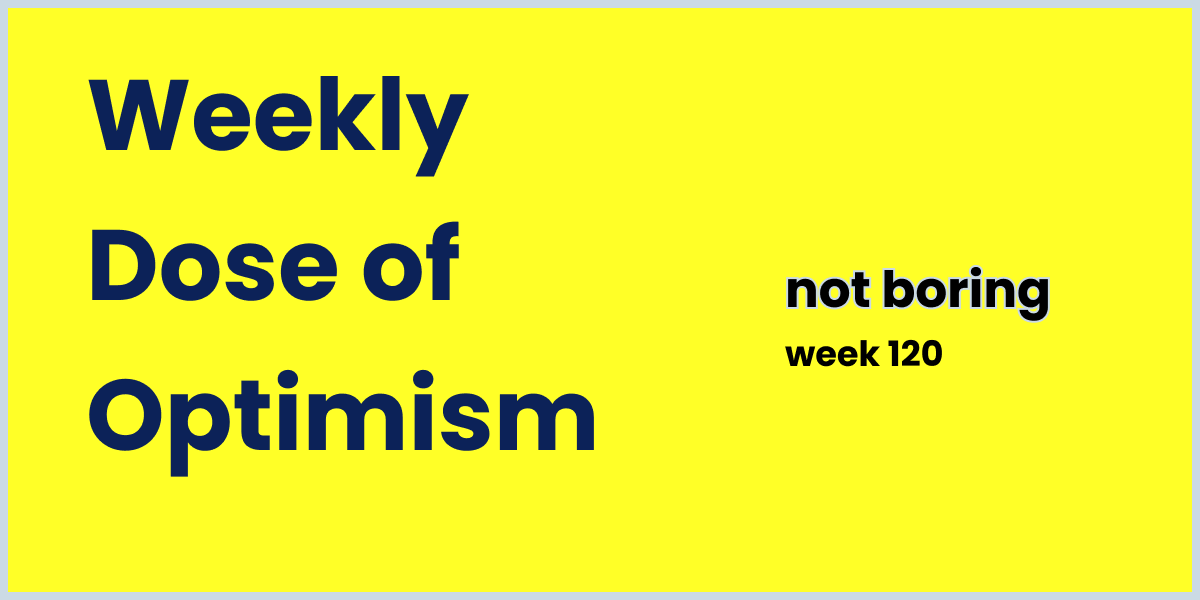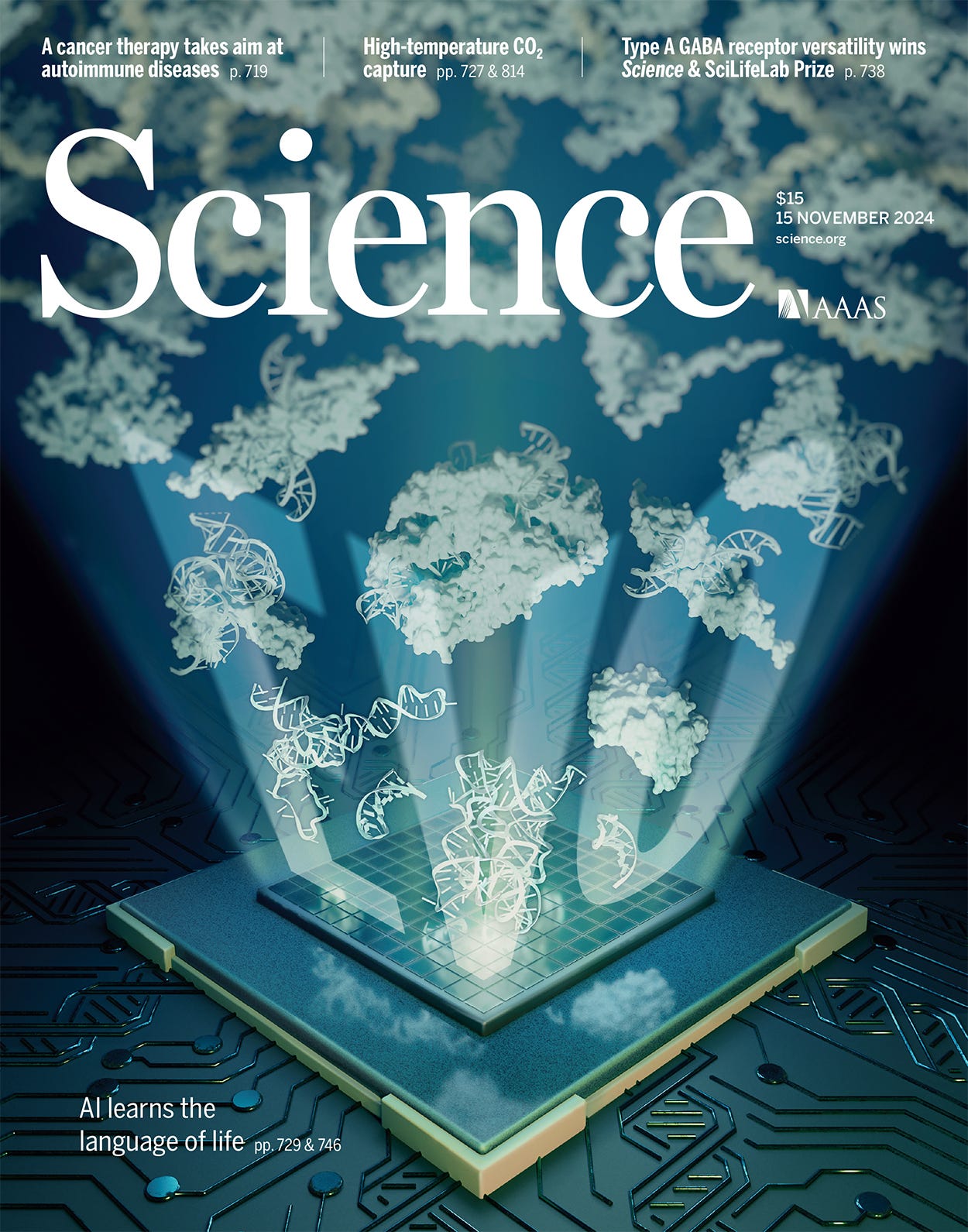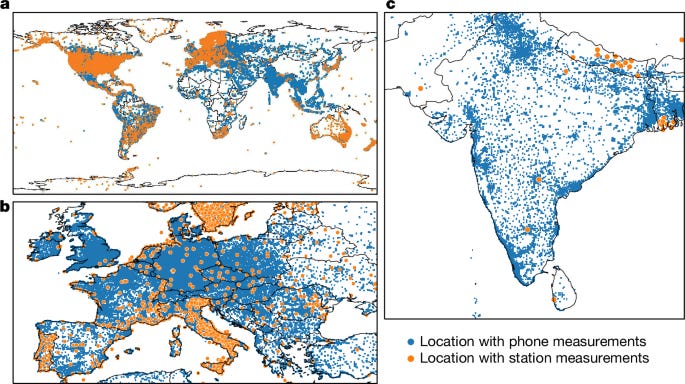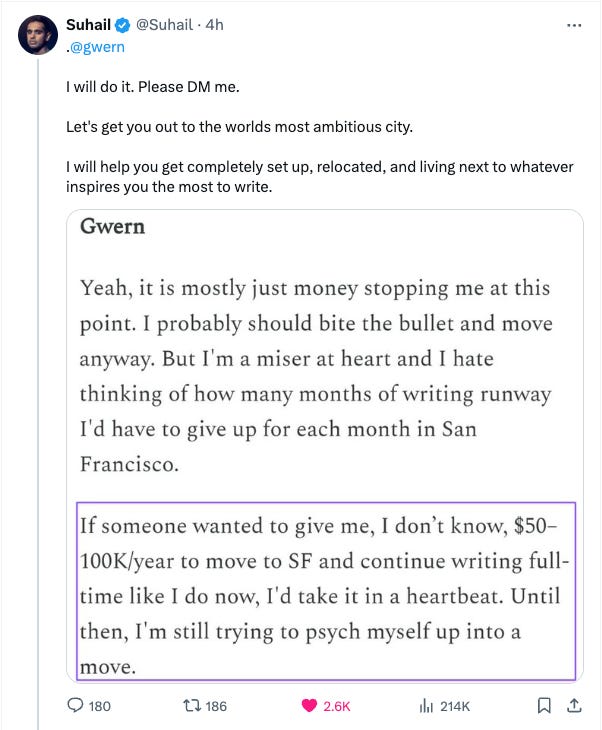Not Boring by Packy McCormick - Weekly Dose of Optimism #120
Weekly Dose of Optimism #120Nuclear Plans, Nanotechnology, Evo, AlphaFold 3, Crowdsourced Networks, CRISPR TomatoesToday’s Weekly Dose is brought to you by… Speakeasy Speakeasy recently raised $15M to revolutionize REST API development. Even the most gifted craftsman needs the appropriate tools to build something they’re proud of. Unfortunately, the API tooling ecosystem is still stuck in 2005. Speakeasy wants to make it trivially easy for every developer to build great APIs. To make that dream a reality, Speakeasy is building a platform to handle the heavy lifting of API development and unburden developers to focus on refining the business logic. From fast-growing innovators like Vercel, Mistral AI, and Kong to hobby projects by solo devs, engineers use Speakeasy to accelerate their API development and adoption. Hi friends 👋, Happy Friday and welcome back to our 120th Weekly Dose of Optimism. Even during the most chaotic of times, we can rely on the world producing (at least) five optimistic stories worthy of coverage in The Weekly Dose of Optimism. It’s like clockwork. This week, Joe snuck in some huge last minute plans for a nuclear buildout, plus the future of nanotechnology, distributed networks, gene editing, and much more. In fact, this might be the most action-packed Dose in a long time. Humans rock. Let’s get to it. (1) US Unveils Plan to Triple Nuclear Power by 2050 as Demand Soars
Go Joe! On Thursday, the Biden Administration unveiled plans to triple US nuclear power capacity by 2050, adding 200 gigawatts through new reactors, plant restarts, and upgrades. In addition, the plan calls for 35 gigawatts of new capacity within a decade. This is one of the most ambitious plans for nuclear energy ever laid out by a U.S. president — instead of maintaining the status quo or focusing entirely on safety concerns, the plan meets bipartisan momentum for nuclear energy, which has been pulled forward by the AI boom and other geopolitical issues. Nuclear buildout has stagnated for the last 50+ years, with barely any capacity added since the 90s. This plan flips that with a goal to not only increase nuclear capacity, but triple it within 25 years. The plan itself is pretty on point. Joe must’ve been a Age of Miracles listener. The plan calls for capacity expansion through the construction of new sites and the revival of idle plants, the deployment of small reactors, and public/private partnership to make it all happen. The plan also calls for a number of regulatory and policy changes to make this all possible: expanding the skilled-labor workforce to build and work on these sites, removing regulatory barriers to construction and operation, and tax policies to make it all economically feasible. Let’s just hope DOGE doesn’t come after this specific governmental initiative… (2) Two Paths to Molecular Nanotechnology
Packy here. Jacob Rintamaki wrote a deep piece on what it would take to make molecular technology happen. Aside from being well-researched and ridden with rabbit holes to explore, this one is fascinating to me for a few reasons. First, nanotech is one of those sci-fi technologies (like anti-gravity) that could decimate a large percentage of current companies when we figure it out, as we covered when we talked about J. Storrs Hall’s essay on Nanotech for Abundance Institute. It will be interesting to see what happens to the market if and when molecular nanotechnology approaches realization and scale. Second, a few weeks ago, I wrote What Do You Do With an Idea?, in which I noted that many of the hard tech companies being built today are based on ideas from the 1950s and 1960s. The idea for manipulating matter at the level of individual atoms was proposed by Richard Feynman in a 1959 lecture, Plenty of Room at the Bottom. In that essay, I wrote:
What I love about Jacob’s post is that he’s serving as the Librarian — taking the old idea, tracking its history, and detailing which technologies and costs might make it economically viable after all these years — and hinting in the conclusion that he might also be attempting to serve as the Vanderbilt, Ford, or Wright of Molecular Nanotechnology — plucking from the pile of withered ideas and combining them in new ways. The list of things humanity might do with nanotech is practically limitless. In his piece, Hall previews step changes in manufacturing, robotics, construction, energy, and transportation, and a nail in the coffin of the idea that the world is resource-constrained. I hope Jacob is right that the time to build nanotech is now, so I’m amplifying this: “if you are an investor, technologist (particularly in AI, protein design, or scanning probe microscopy), or just a nanotechnology enthusiast, then I would appreciate further communication with you via my X account @jacobrintamaki or my email address, jrin at stanford dot edu.” (3) Evo: Creating Generative AI for Genomes Arc Institute
Jacob might have some help in the quest for molecular nanotechnology from Evo, a new foundation model for biology built by The Arc Institute, Stanford, and UC Berkeley researchers. Evo, which appears on the cover of Science, can both interpret and generate biological sequences spanning from individual nucleotides all the way up to genome-scale designs over a million bases long. According to Arc, “Evo is capable of both prediction and design not just at the level of DNA but also across RNA and proteins. Its interpretive and generative capabilities span biological scales, from nucleotides to the whole genome—bringing entire life forms into focus.” To demonstrate Evo's capabilities, the team designed EvoCas9-1, a fully functional CRISPR system that emerged after testing just eleven AI-generated designs. Despite sharing only 73% of its sequence with traditional CRISPR-Cas9, the new system achieved comparable activity - suggesting there may be vast unexplored spaces of effective biological tools waiting to be discovered. The researchers are now scaling up, moving beyond single-cell organisms toward more complex multicellular life forms, with the ambitious long-term goal of enabling an entirely new field of "genome design" where we could potentially create custom cellular pathways and organisms from scratch. Evo is notable for it capabilities — it’s a tool that might one day help us design life — and for its origins — another win for the Arc Institute, and for new approaches to doing science. (4) Google DeepMind open-sources AlphaFold 3 From VentureBeat
If you like using AI for biology, there’s more where that came from! AlphaFold 3 is now open source! As a reminder, AlphaFold is an AI system that predicts protein structures, which is key to understanding how biology works. AlphaFold 3 takes it to the next level, modeling how proteins interact with DNA, RNA, and small molecules with incredible precision. It's a game-changer for drug discovery and molecular research. And it’s now available for academic use. This is one of the positives of monopolies: Google has likely spent tens of billions of dollars building AlphaFold 3 and because it’s not directly crucial to its core monopoly business of search, it feels comfortable enough open sourcing it. The move will certainly accelerate scientific research and drug discovery. But it’s not entirely altruistic: the move bolster’s Google’s role as a leader in AI, builds goodwill with researchers, and ultimately should attract more top talent, plus the open sourcing is not without its limitations, as its only available for academic use and Google still protects its use in commercial applications. (4) Mapping the ionosphere with millions of phones Smith et al in Nature
I love when Silicon Valley becomes real life. Google just proved out a version of Pied Piper. Kinda. Sorta. Google turned 40 million Android phones into a massive, crowdsourced scientific tool to map the Earth’s ionosphere in real time, filling gaps in satellite data. For the uninitiated, the ionosphere is a layer of Earth’s upper atmosphere filled with charged particles that affects radio waves and satellite signals. This research enhances GPS accuracy globally, especially in previously low coverage zones, and could also unlock new insights on space weather. The coolest part, though, is that this was all achieved using everyday technology that was already in peoples’ pockets. Pied Piper may have not worked out (most startups fail!), but we’re happy to see that Google could build off of the technological breakthroughs the startup achieved.  Bonus 1: CRISPR builds a big tomato that’s actually sweet Max Kozlov for Nature
*Imagine me delivering this story as David Friedberg in Science Corner* Researchers used CRISPR to edit two genes in tomatoes, increasing their glucose and fructose levels by up to 30% without sacrificing size or yield. If you’re anything like me, your average grocery store tomato isn’t doing it for you — it’s watery and bland. This new methodology could restore the sweetness of tomatoes, without sacrificing size constraints or negatively impacting farming yields. Of course, tomato sweetness is really just the start. It’s not a huge leap to imagine this technology being used to increase the flavor profile of a number of other fruits and vegetables, and importantly, doing so in a way that doesn’t negatively impact farming productivity or economics. Genetic modification of foods has gotten a bad wrap over the years — in reality, it’s a bit more nuanced: being able to mass produce safe, tasty food has come with tradeoffs. But this type of CRISP gene medication is generally viewed as better. It offers precise, natural-like genetic modifications without introducing foreign DNA, reducing unintended effects and improving safety and efficiency as compared to traditional GMOs. Bonus 2: I tried to melt down a real-life nuclear reactor Christian Keil for First Principles 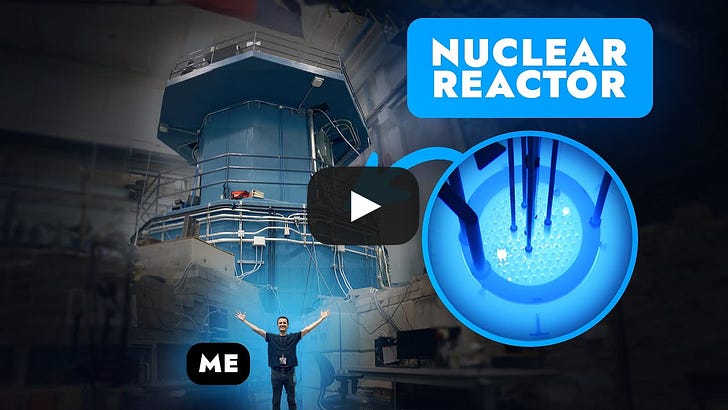 Friend of Not Boring Christian Keil takes his show, First Principles, to Austin to pull the control rod out of a nuclear reactor and see what happens. Spoiler: he survived. Bonus 3: The Return of Medici-Style Patronage Packy again. On Wednesday, the legendary blogger Gwern went on Dwarkesh Podcast for his first public podcast, using an avatar and someone else’s voice to maintain anonymity. During the conversation, he mentioned that he was living on $900-1,000 per month in Patreon fees, which is a shockingly low amount for someone so influential. Dwarkesh asked what it would take for him to move to SF, and he said $50-100k/year. Dwarkesh set up a Stripe donation link, which I’m sure raised a ton of money, and then Mixpanel & Playground AI founder Suhail Doshi gave him the full amount. It remains to be seen how Gwern’s writing holds up to being in the scene in SF — there’s something pristine about living the hermetic life in the middle of nowhere, with no obligations or temptations — but it’s one of the more public and generous recent examples of a resurgence of Medici-style patronage among people in tech. Tyler Cowen does Emergent Ventures Grants. Jim O’Shaughnessy gives O’Shaughnessy Fellowships and runs Infinite Films. Marc Andreessen gave a $50k no-strings-attached grant to a twitter-based AI agent, Truth Terminal, and its creator, Andy Ayrey. Yesterday, the Collison-supported Arc Institute hit the cover of Science with its Evo model for predicting, generating, and engineering entire genomic sequences. Dwarkesh himself kept podcasting in the early days thanks to a $10,000 gift from Meter’s Anil Varanasi. The more patronage of the arts and sciences, the better. Yet another sign that we’re living in a Renaissance. Have a great weekend y’all. Thanks to Speakeasy for sponsoring! We’ll be back in your inbox on Tuesday. Thanks for reading, Packy + Dan |
Older messages
The Trump Bubble
Friday, November 15, 2024
Fixing the machine that builds the machines that builds the machines ͏ ͏ ͏ ͏ ͏ ͏ ͏ ͏ ͏ ͏ ͏ ͏ ͏ ͏ ͏ ͏ ͏ ͏ ͏ ͏ ͏ ͏ ͏ ͏ ͏ ͏ ͏ ͏ ͏ ͏ ͏ ͏ ͏ ͏ ͏ ͏ ͏ ͏ ͏ ͏ ͏ ͏ ͏ ͏ ͏ ͏ ͏ ͏ ͏ ͏ ͏ ͏ ͏ ͏ ͏ ͏ ͏ ͏ ͏ ͏ ͏ ͏ ͏ ͏ ͏ ͏
Weekly Dose of Optimism #119
Friday, November 8, 2024
Trump Whale, Underwater Drones, Endometriosis, EDIT-B, Sugar Study, Identity Politics, Jupiter ͏ ͏ ͏ ͏ ͏ ͏ ͏ ͏ ͏ ͏ ͏ ͏ ͏ ͏ ͏ ͏ ͏ ͏ ͏ ͏ ͏ ͏ ͏ ͏ ͏ ͏ ͏ ͏ ͏ ͏ ͏ ͏ ͏ ͏ ͏ ͏ ͏ ͏ ͏ ͏ ͏ ͏ ͏ ͏ ͏ ͏ ͏ ͏ ͏ ͏ ͏ ͏ ͏
Read More Books
Tuesday, November 5, 2024
An election palette cleanser on why and how to read ͏ ͏ ͏ ͏ ͏ ͏ ͏ ͏ ͏ ͏ ͏ ͏ ͏ ͏ ͏ ͏ ͏ ͏ ͏ ͏ ͏ ͏ ͏ ͏ ͏ ͏ ͏ ͏ ͏ ͏ ͏ ͏ ͏ ͏ ͏ ͏ ͏ ͏ ͏ ͏ ͏ ͏ ͏ ͏ ͏ ͏ ͏ ͏ ͏ ͏ ͏ ͏ ͏ ͏ ͏ ͏ ͏ ͏ ͏ ͏ ͏ ͏ ͏ ͏ ͏ ͏ ͏ ͏ ͏ ͏ ͏ ͏ ͏ ͏ ͏
Weekly Dose of Optimism #118
Friday, November 1, 2024
Scent Teleportation, Semaglutide & AD, First Generalist Policy, Semaglutide...Again, OXMAN, Astro Mechanica ͏ ͏ ͏ ͏ ͏ ͏ ͏ ͏ ͏ ͏ ͏ ͏ ͏ ͏ ͏ ͏ ͏ ͏ ͏ ͏ ͏ ͏ ͏ ͏ ͏ ͏ ͏ ͏ ͏ ͏ ͏ ͏ ͏ ͏ ͏ ͏ ͏ ͏ ͏ ͏ ͏ ͏ ͏ ͏ ͏
Infinity Missions
Tuesday, October 29, 2024
From Pascal's Wager to Digital Gods ͏ ͏ ͏ ͏ ͏ ͏ ͏ ͏ ͏ ͏ ͏ ͏ ͏ ͏ ͏ ͏ ͏ ͏ ͏ ͏ ͏ ͏ ͏ ͏ ͏ ͏ ͏ ͏ ͏ ͏ ͏ ͏ ͏ ͏ ͏ ͏ ͏ ͏ ͏ ͏ ͏ ͏ ͏ ͏ ͏ ͏ ͏ ͏ ͏ ͏ ͏ ͏ ͏ ͏ ͏ ͏ ͏ ͏ ͏ ͏ ͏ ͏ ͏ ͏ ͏ ͏ ͏ ͏ ͏ ͏ ͏ ͏ ͏ ͏ ͏ ͏ ͏ ͏ ͏ ͏ ͏
You Might Also Like
Are secondaries a liquidity mirage?
Saturday, March 29, 2025
Also: The impact of China's $138B high-tech fund; How is PE navigating 2025?; Real estate returns are improving. but fundraising has been harder... Read online | Don't want to receive these
'Lean Into Your Heart: Let Your Passion Drive You'
Saturday, March 29, 2025
We spoke with award-winning producer and director Mike Tollin about his Philly roots, the leadership shift between producing and directing, the values that guide his life, and what truly makes for
2.5x more sales without acquiring new users
Saturday, March 29, 2025
Launching a product? I'm helping startups build better products and reach product-market fit. To do that, we've built ProductMix and you should use it: https://rockethub.com/deal/productmix
Winners and Losers?
Friday, March 28, 2025
The dust has (mostly) settled. Google's March 2025 Core Update is officially complete ͏ ͏ ͏ ͏ ͏ ͏ ͏ ͏ ͏ ͏ ͏ ͏ ͏ ͏ ͏ ͏ ͏ ͏ ͏ ͏ ͏ ͏ ͏ ͏ ͏ ͏ ͏ ͏ ͏ ͏ ͏ ͏ ͏ ͏ ͏ ͏ ͏ ͏ ͏ ͏ ͏ ͏ ͏ ͏ ͏ ͏ ͏ ͏ ͏ ͏ ͏ ͏ ͏ ͏ ͏ ͏
Sam Altman Says Your Silly Image Editing Is Melting Its GPUs
Friday, March 28, 2025
You're an Amazon whiz... but maybe not an email whiz. Omnisend makes setting up email for your brand as easy as click, drag, and drop. Make email marketing easy. Hey Reader, First, our prayers and
A Tale of Two Crypto Markets
Friday, March 28, 2025
Calmer Seas Are Ahead
Google's AI - Your "travel agent"
Friday, March 28, 2025
It's booking vacations and paying your bills.
Disruptive Marketing Tactics, Instagram Measurement, Meta Ads Branding Controls, and More
Friday, March 28, 2025
Today's Guide to the Marketing Jungle from Social Media Examiner... presented by social-media-marketing-world-logo The weekend is almost here, Reader! Before you unplug, here's one last round
Q&A: How startups should sell AI
Friday, March 28, 2025
VC secondaries home in on trendy startups; real estate funds hit 22 months to close; taking PE's pulse Read online | Don't want to receive these emails? Manage your subscription. Log in The
Influence Weekly #382 - This Is What A $300 Million TikTok Strategy Looks Like
Friday, March 28, 2025
E-Commerce Veteran Shares Key Insights After Spending $10M On Influencer Marketing Campaigns
